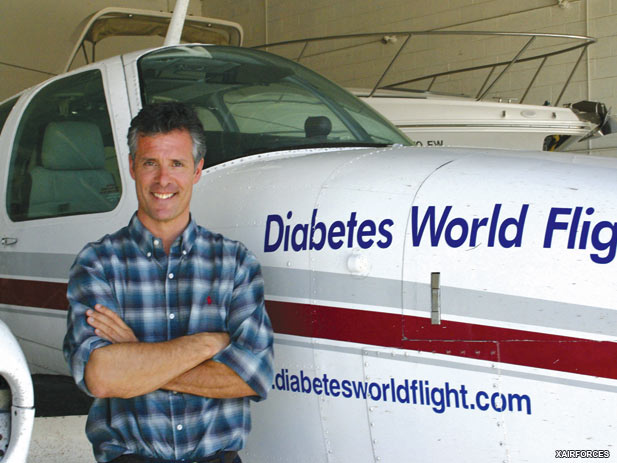
Diabetic pilot aims for record-breaking flight

Diabetic pilot Douglas Cairns plans a flying expedition to the North Pole to show what those with his illness can accomplish in the air.
In most of the world, diabetics are forbidden from flying private planes.
Cairns had to give up his British Royal Air Force career when he was diagnosed with diabetes in 1989. Now he is mounting an expedition for the record books.
In late April, when daylight and ice conditions are expected to be optimal, he plans to take off from Barrow, Alaska, and fly about 1,300 miles to the North Pole and back.
Cairns, who flies a twin-engine Beechcraft Baron, said the journey would make him the first pilot to land a light, twin-engine piston aircraft at the pole, a claim backed up by a spokesman for Guinness World Records.
The North Pole expedition is the latest in a series of aerial feats by Cairns and friends, including various speed records in the United States and a team effort that set a record for landing in each of the 50 states.
"It's just been great to be able to take up these projects to spread the message of what you can do with diabetes, rather than what you can't," said Cairns, who was in Anchorage, Alaska, making preparations for the North Pole expedition.
He expects to set a speed record for the air route from Barrow to the North Pole, which he intends to complete in about 15 hours, round-trip. The World Air Sports Federation does not list a speed record for that route.
Barrow is the northernmost community in the United States.
Flights by Cairns and other diabetics have been made possible by U.S. rules that, as of 1997, relaxed restrictions for pilots with the disease.
He has made training flights to practice landings on frozen lake surfaces. At the North Pole, he hopes to find a strip of smooth sea ice, land and stay on the ground for 30 minutes, then make the long trip back to Barrow.
Because he will be flying over U.S. and international territory, Cairns will be allowed to pilot his plane solo.
But an Alaska partner will, ahead of time, take a plane equipped with skis for landing, to scout out a suitable touch-down spot on the ice. Cairns' plane has wheels.
The United States is among only five nations that allow diabetic pilots to fly private planes, according to the international organization Pilots with Diabetes.
U.S. rules allow diabetics on insulin treatment to fly solo, as long as they regularly monitor their blood sugar before and during flights, and take corrective actions when levels fall outside a safe zone.
Source: By Yereth Rosen - ANCHORAGE, Alaska | Thu Mar 31, 2011- (Reuters)
(2.04.2011)
|